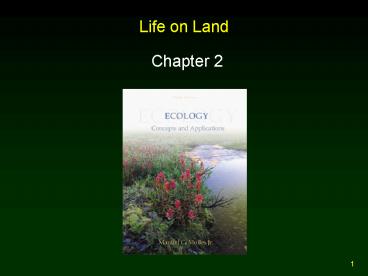Life on Land PowerPoint PPT Presentation
1 / 35
Title: Life on Land
1
Life on Land
- Chapter 2
2
Outline
- Introduction
- Temperature, Atmospheric Circulation, and
Precipitation - Climate Diagrams
- Soil Horizons
- Terrestrial Biomes
3
Introduction
- Janzen studied natural history of tropical dry
forests in Costa Rica to aid restoration efforts. - Guanacaste tree (E. cyclocarpum) has no current
dependable dispersers, thus trees produce massive
numbers of fruits. - Last native dispersers went extinct 10,000 years
ago. - Cattle and horses (exotics) now act as dispersers.
4
Dispersers of Guanacaste Seeds
5
Terrestrial Biomes
- Biomes are distinguished primarily by their
predominant plants and are associated with
particular climates. - Geographic and seasonal variations in temperature
and precipitation are fundamental components.
6
Temperature, Atmospheric Circulation, and
Precipitation
- Spherical shape and tilt of earths axis cause
uneven heating of earths surface. - Drives air circulation patterns and consequently
precipitation patterns. - Warm, moist air rises.
- Cools, condenses, and falls as rain.
- Cooler, dry air falls back to surface.
- Rainforests found near equator.
- Major deserts found near 30o N / S.
7
Solar-Driven Air Circulation
8
Temperature, Atmospheric Circulation, and
Precipitation
- Coriolis effect causes apparent deflection of
winds clockwise in the N hemisphere and
counterclockwise in the S hemisphere.
9
Climate Diagrams
- Summarize climatic information using a
standardized structure. - Temperature plotted on left vertical axis.
- Precipitation plotted on right vertical axis.
- 10o C equivalent to 20 mm precipitation.
- Relative position of lines reflect water
availability. - Adequate moisture for plant growth when
precipitation above temperature.
10
Climate Diagrams
11
Soil Foundation of Terrestrial Biomes
- Soil is a complex mixture of living and
non-living material. - Classification based on vertical layering (soil
horizons). - Profile provides a snapshot of soil structure in
a constant state of flux.
12
Soil Horizons
- O horizon Organic Layer freshly fallen organic
material - most superficial layer. - A horizon Mixture of minerals, clay, silt and
sand. - B horizon Clay, humus, and other materials
leached from A horizon - often contains plant
roots. - C horizon Weathered parent material.
13
Soil Profile
14
Tropical Rainforests
- Most occur within 10o latitude of equator.
- Little temperature variation between months.
- Annual rainfall of 2,000 - 4,000 mm relatively
evenly distributed. - Quickly leaches soil nutrients.
- Mycorrhizae help gather nutrients.
- Organisms add vertical dimension.
- Harbor staple foods and medicines for worlds
human populations - increasingly exploited.
15
Tropical Rainforests
16
Tropical Dry Forest
- Usually located between 10o - 25o latitude.
- Climate more seasonal than tropical rainforest.
- Soils generally richer in nutrients, but
vulnerable to erosion. - Shares many animal and plant species with
tropical rainforests. - Heavily settled by humans with extensive clearing
for agriculture.
17
Tropical Dry Forest
18
Tropical Savanna
- Most occur north and south of tropical dry
forests within 10o - 20o of the equator. - Climate alternates between wet / dry seasons.
- Drought associated with dry season leads to
lightning-caused wildfires. - Soils have low water permeability.
- Saturated soils keeps trees out.
- Landscape is more two-dimensional with increasing
pressure to produce livestock.
19
Tropical Savanna
20
Desert
- Major bands at 30o N and 30o S latitude.
- Occupy about 20 of earths land surface.
- Water loss usually exceeds precipitation.
- Soil usually extremely low in organic matter.
- Plant cover ranges from sparse to absent.
- Animal abundance low, but biodiversity may be
high. - Strong behavioral adaptations.
- Human intrusion increasing.
21
Desert
22
Mediterranean Woodland and Shrubland
- Occur in all continents except Antarctica.
- Climate cool and moist in fall, winter, and
spring, but can be hot and dry in summer. - Fragile soils with moderate fertility.
- Trees and shrubs typically evergreen.
- Fire-resistant plants due to fire regime.
- Long history of human intrusion.
- Cleared for agriculture.
23
Mediterranean Woodland and Shrubland
24
Temperate Grassland
- Extremely widespread distribution.
- Annual rainfall 300 - 1,000 mm.
- Experience periodic droughts.
- Soils tend extremely nutrient rich and deep.
- Thoroughly dominated by herbaceous vegetation.
- Large roaming ungulates.
- Bison vs. cattle
25
Temperate Grassland
26
Temperate Forest (Old Growth)
- Majority lie between 40o and 50o latitude.
- Rainfall averages 650 - 3,000 mm.
- Fertile soils
- Long growing seasons dominated by deciduous
plants. - Short growing seasons dominated by conifers.
- Biomass production can be very high.
- Many major human population centers.
27
Temperate Forest (Old Growth)
28
Boreal Forest (Taiga)
- Confined to Northern Hemisphere.
- Covers 11 of earths land area.
- Thin, acidic soils low in fertility.
- Generally dominated by evergreen conifers.
- Relatively high animal density.
- Historically, low levels of human intrusion.
29
Boreal Forest (Taiga)
30
Tundra
- Covers most of lands north of Arctic Circle.
- Climate typically cool and dry with short
summers. - 200 - 600 mm precipitation.
- Low decomposition rates.
- Supports substantial numbers of native mammals.
- Human intrusion historically low, but increasing
as resources become scarce.
31
Tundra
32
Mountains Islands in the Sky
- Built by geological processes and thus
concentrated in belts of geological activity. - Climate changes with elevation and latitude.
- Soils are generally well-drained and thin.
- Flora and fauna change with elevation.
- Historically used as a source of raw materials
for human settlements.
33
Mountains Islands in the Sky
34
Review
- Introduction
- Temperature, Atmospheric Circulation, and
Precipitation - Climate Diagrams
- Soil Horizons
- Terrestrial Biomes
35
(No Transcript)

